Phylum cnidaria - Study guides, Class notes & Summaries
Looking for the best study guides, study notes and summaries about Phylum cnidaria? On this page you'll find 132 study documents about Phylum cnidaria.
Page 4 out of 132 results
Sort by
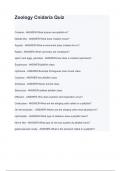
-
Zoology Cnidaria Quiz with correct answers
- Exam (elaborations) • 1 pages • 2024
-
- $7.99
- + learn more
Cnidaria - ANSWER-What phylum are jellyfish in? Needle-like - ANSWER-What does cnidaria mean? Aquatic - ANSWER-What environment does cnidaria live in? Radial - ANSWER-What symmetry are cnidarians? sperm and eggs, gametes - ANSWER-How does a cnidaria reproduce? Scyphozoa - ANSWER-jellyfish class Hydrozoa - ANSWER-Example Portuguese man-of-war class Cubozoa - ANSWER-box jellyfish class Anthezoa - ANSWER-flower animal class Staurozoa - ANSWER-stalked jellyfish class Diffusion - ANSWER-How...
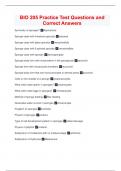
-
BIO 205 Practice Test Questions and Correct Answers
- Exam (elaborations) • 9 pages • 2024
- Available in package deal
-
- $9.49
- + learn more
Symmetry of sponges? Asymetrical Sponge class with limestone spicules calcarea Sponge class with glass spicules hexactinellida Sponge class with 6 pointed spicules hexactinellida Sponge class with spongin demospongiae Sponge body form with choanoderm in the spongocoel asconoid Sponge form with choanocyte chambers leuconoid Sponge body form that can have porocytes or dermal pores syconoid Cells on the outside of a sponge exopinacocytes What cells make sperm in sponges? choanocytes What ...

-
BIOL 198 Module 7 Exam Questions With 100% Correct Answers
- Exam (elaborations) • 18 pages • 2024
-
- $12.49
- + learn more
BIOL 198 Module 7 Exam Questions With 100% Correct Answers Identify the characteristics that distinguish animals from other types of organisms. - answerMulticellular Heterotrophic Motile Reproduce sexually Use aerobic metabolism Lack cell walls Have life cycles that include development from undifferentiated cells Have a variety of body plans Distinguish between asymmetry, radial symmetry, and bilateral symmetry. - answerAsymmetry: no particular organization Radial symmetry: Circular...
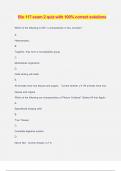
-
Bio 117 exam 2 quiz with 100% correct solutions
- Exam (elaborations) • 49 pages • 2024
-
- $13.49
- + learn more
Bio 117 exam 2 quiz with 100% correct solutions Which of the following is NOT a characteristic of ALL animals? A. Heterotrophic B. Together, they form a monophyletic group. C. Multicellular organisms D. Cells lacking cell walls. E. All animals have true tissues and organs. - Correct Answer ️️ -All animals have true tissues and organs. Which of the following are characteristics of Phylum Cnidaria? (Select All that Apply) A. Specialized stinging cells B. True Tissues C. Comp...
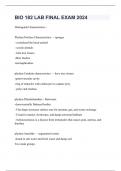
-
BIO 182 LAB FINAL EXAM 2024
- Exam (elaborations) • 11 pages • 2024
- Available in package deal
-
- $13.99
- + learn more
Distinguish Characteristics - Phylum Porifera Characteristics - - sponges - considered the basal animal - sessile animals - lack true tissues -filter feeders -hermaphrodites phylum Cnidaria characteristics - - have true tissues -gastrovascular cavity -ring of tentacles with cnidocytes to capture prey - polys and medusa phylum Platyhelminthes - flatworms -dorsoventrally flattened bodies - Flat shape increases surface area for nutrient, gas, and waste exchange - Found in mar...

-
CSCC Bio 1114 Exam 3 Questions and Answers Graded A 2024
- Exam (elaborations) • 10 pages • 2024
-
- $14.49
- + learn more
Phylum of Parazoa and etc - Porifera = pore bearing = sponges with no tissues Sessile adults, mostly marine Asymmetrical or Radial symmetry Sponge morphology voacb - spongocel, choanocytes, mesohyl, amoebocytes Spongocel, osculum, ostium - central cavity of the sponge, large opening, pores choanocytes - collared cells; flagellated, line the spongocel and beat in unison and move water towards the top osculum; water goes in through the pores with food that may or may not be good to eat ...
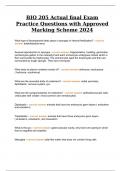
-
BIO 205 Actual final Exam Practice Questions with Approved Marking Scheme 2024
- Exam (elaborations) • 30 pages • 2024
- Available in package deal
-
- $12.99
- + learn more
BIO 205 Actual final Exam Practice Questions with Approved Marking Scheme 2024 What type of development takes place in sponges in internal fertilization? - correct answer amphiblastula larva Asexual reproduction in sponges - correct answer fragmentation, budding, gemmules (archeocytes gather in the mesophyll and each archeocyte undergoes mitosis which is then surrounded by trophocytes. The archeocytes egult the trophocytes and then are surrounded by tough spongin. They have micropyle. Wha...
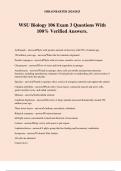
-
WSU Biology 106 Exam 3 Questions With 100% Verified Answers.
- Exam (elaborations) • 14 pages • 2024
- Available in package deal
-
- $10.49
- + learn more
WSU Biology 106 Exam 3 Questions With 100% Verified Answers. Arthropods - answerPhyla with greatest amount of diversity with 85% of animal spp 700 million years ago - answerWhen the first animals originated Porifera (sponges) - answerPhyla with no tissues, muscles, nerves, or specialized organs Choanocytes - answerFlow of water and food acquisition in sponges Amoebocytes - answerFound in sponges, these cells are mobile and perform numerous functions, including reproduction, transport of f...
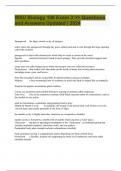
-
WSU Biology 106 Exam 3 >> Questions and Answers Updated | 2024
- Exam (elaborations) • 14 pages • 2024
- Available in package deal
-
- $12.49
- + learn more
WSU Biology 106 Exam 3 >> Questions and Answers Updated | 2024 Spongocoel the large central cavity of sponges. water enters the spongocoel through tiny pores called ostia and it exits through the large opening called the osculum. spongocoel is lined with choanocytes which help to create a current in the water. Spicule structural elements found in most sponges. They provide structural support and deter predators. Large ones are called megascleres while microscopic ones...
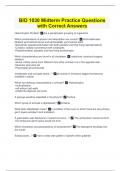
-
BIO 1030 Midterm Practice Questions with Correct Answers
- Exam (elaborations) • 5 pages • 2024
- Available in package deal
-
- $8.99
- + learn more
Heterotrophic Protists? Are a paraphyletic grouping of organisms Which combinations of phylum and description are correct? -Echinodermata: bilateral symmetrical larvae and pentaradially symmetrical adult -Nematoda: pseudocoelomates with both parasitic and free living representatives -Cnidaria: radially symmetrical with cnidocytes -Platyhelminthes: parasitic and free-living acoelomates Which characteristics are found in all chordates: -notochord: structural support, skeleton, -dorsal, hollow ne...

Study stress? For sellers on Stuvia, these are actually golden times. KA-CHING! Earn from your study resources too and start uploading now. Discover all about earning on Stuvia


